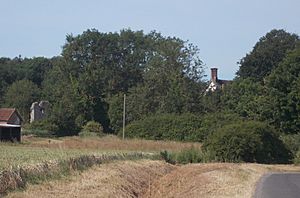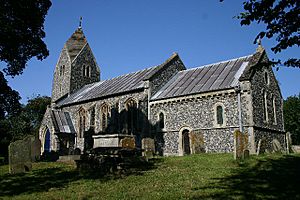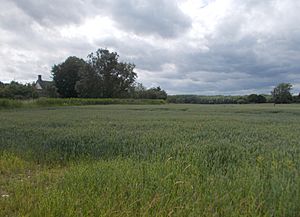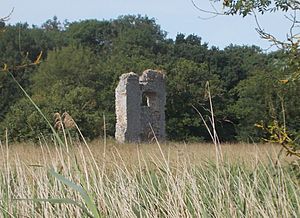Flixton Priory facts for kids
Flixton Priory was a home for nuns who followed the rules of St. Augustine. It was located in a place called Flixton in Suffolk, England. This priory was about 3 miles (5 km) southwest of Bungay. Margery de Creke started it in 1258. The priory was closed down in 1536 or 1537. It was known as one of the poorest nunneries in its area.
Today, you can find the priory's old site at Abbey Farm. It was surrounded by a moat, like a small island. Not much is left of the original buildings, just a small part of a wall. The site has been protected as an ancient monument since 1953. It's private property, so you can't visit it. Some people think that stones from the priory might have been used to build St Peter's Hall nearby.
Long ago, Flixton was owned by the Bishop of East Anglia. This was around the time of the Domesday Book. Some historians believe that Flixton got its name from St Felix, who was an early bishop in the 7th century. This area was a good place for a religious building in the 1200s.
Contents
Who Started Flixton Priory?
Margery de Hanes was the founder of Flixton Priory. She married Bartholomew de Creke. Her family owned land in places like Hillington, Norfolk and Flixton. Bartholomew's family was also important. They were connected to other powerful families in the area.
Bartholomew's sister, Isabel, married into the Valoines family. This family had also started other nunneries, like Hickling Priory and Campsey Priory. Margery and Bartholomew owned several manors, which were large estates with land and houses.
How the Priory Began (1256–1292)
The First Steps
Bartholomew de Creke died around 1252. Margery de Creke, his wife, kept control of her family's lands. In 1256, she got permission to start a religious house in Flixton.
In 1258, Margery officially gave her entire manor of Flixton to a group of religious women. These women followed the rules of St. Augustine. They served God, St Mary, St Katharine, and All Saints. Margery made this gift for the good of her own soul and for her family. Her oldest son, Robert, agreed to this.
The new monastery was planned for 18 nuns and a prioress. The first prioress was named Alianora. The priory buildings were located on a plateau overlooking the River Waveney valley. The Bishop of Norwich, Simon de Wanton, helped Margery with her early gifts to the priory.
Early Gifts and Support
Close to the priory was St Mary's Church. Its large tower was very old, from Anglo-Saxon times. Margery de Creke gave her share of the church's ownership to the priory in 1260. Other people also gave land to the priory.
The priory also gained control of churches in Dunston, Norfolk (in 1264) and Shipmeadow (in 1269). Beatrice (de Ratlesden) became the prioress around this time. Margery de Creke continued to support the priory. She gave the priory more land and the right to choose the priest for the church in Combs around 1275.
In 1280, Margery gave the Bishops of Norwich the right to oversee the priory. She died around 1286. After her death, the priory continued to receive support from her family. They received land and rights to churches in places like Helmingham and Fundenhall.
The church in Dunston is named after St Remigius. There is old stained glass in this church from the 1300s. It shows a kneeling woman praying to the saint. This might be Margery de Creke herself, showing her support for the church and priory.
Challenges and Changes (1292–1357)
Facing Poverty
After Margery's family line became complicated, the priory faced financial difficulties. Emma de Welholm became prioress in 1301. In 1310, the priory was allowed to get more land. This was because their current income was not enough to support the nuns.
Flixton Priory had a small amount of money and land compared to other places. This made it quite poor. In 1321, Bishop John Salmon of Norwich helped the priory. He exchanged his share of the Flixton church for the Helmingham church. This helped the priory get more income from the Flixton church. The bishop noted how poor the priory was. He said the nuns struggled to buy food and drink for themselves and for visitors.
New Rules and Support
Isabel Weltham became prioress in 1345. Bishop William Bateman became Bishop of Norwich two years later. His family was very involved with Flixton. They bought a lot of land there.
By 1348, the priory was so poor they couldn't pay their taxes. They were given a two-year break from taxes. A month later, they were allowed to take over the church of Fundenhall. This was because many people in Dunston, who helped support the priory, had died in the Black Death. The land was not being farmed, so the nuns had even less to live on.
Bishop Bateman created new rules for the nuns of Flixton Priory. These rules were written in a language called Anglo-Norman. He died in 1355. By 1357, Joan de Hemynhall was the prioress. Bishop Bateman's changes helped the priory. In 1359, they were able to get more land and houses, which helped their finances.
The Priory Buildings
The Moat
The priory site was surrounded by a moat. This moat was roughly rectangular. The north side of the moat was the widest, about 15 to 20 meters across. It was about 110 meters long. The moat channel was about 10 meters wide. Inside the southern part of the moat, there was a pond. This pond was about 35 meters long. There were signs of another pond nearby. These ponds were likely used as fishponds for the priory.
What's Left of the Buildings?
The main priory buildings were in the middle of the moated area. The farmhouse there today is built near where the priory church stood. It even has some old stone walls from the priory. The nuns' living area, called the cloister, was on the south side of the church.
You can still see a part of the outer south wall of the priory. This wall has a window opening. This part of the building was probably the nuns' dining hall, called the refectory.
It is believed that many old stones from Flixton Priory were moved after it closed. These stones included arched doorways and windows. They might have been used to build St Peter's Hall in South Elmham. This would have happened around 1539. If this is true, it means the priory had some important building work done in the 1300s and 1400s.
Priory Symbols
The priory had its own special seal. It was shaped like a diamond. It showed Jesus on the cross with St Mary and St John standing below. It also had symbols of the four writers of the Gospels. At the bottom, it showed a lamb, which is a symbol for Jesus. This seal was used in the 1200s and 1300s.
The priory also had its own coat of arms. It was a blue shield with a silver wheel of St Catherine. This wheel had a cross coming out of the top. This symbol can be seen in old paintings in the church of Fundenhall. It also appears in the stone carvings at St Peter's Hall.
Later Years (1360–1460)
Getting Back on Track
Flixton Priory was always one of the poorest nunneries in its area. Even though it was hit hard by the Black Death, the priory continued to operate in an organized way until it closed. The remaining wall shows that some building improvements were made later on.
In 1370, the priory gained more land and houses in places like Stuston and Great Yarmouth. This extra income helped them pay for a chaplain. This chaplain would hold a special service every Monday for the souls of those who had died. Margery Howell was prioress from 1376 until 1392.
Life in the Community
Katherine Herward became prioress in 1392, followed by Dame Elizabeth Moor in 1402. Around 1414, a list was made of everyone living at the priory. There were 12 nuns and 2 chaplains (priests). There were also many staff members. These included 4 maids, a baker, a cook, a porter, and farm workers like a cowherd and a swineherd. There were also 6 other female servants.
Some people, like Elizabeth Moor (the former prioress), lived at the priory and received food and supplies. They got bread, food, wood, and candles. Having 12 nuns was a good number compared to other nunneries in the area.
Katherine Pilley was prioress for 18 years. She became old and blind. In 1432, she stepped down. The bishop made sure she was cared for in her old age. She had her own rooms with a maid, and received food and beer. Another nun, Cecilia Creke, read prayers with her. Cecilia Creke later became prioress herself in 1446.
The Final Prioresses
Helen was prioress by 1466, then Margery Artis took over. In 1473, a chaplain left a prayer book to Agnes Virly, a nun at Flixton. Elizabeth Virly was prioress in 1493. At that time, there were only six nuns. They were not attending mass in their own church because their priest had a broken arm. The bishop found no major problems.
In 1514, Bishop Nykke visited and found the nuns of Flixton were unhappy. There were eight nuns. Some nuns complained that they only ate bread and cheese three days a week. They also said the rule of silence was not followed. The prioress, Margaret Punder, said some sisters were disobedient. Other nuns complained that the prioress kept money for herself and didn't pay allowances. They also said she didn't keep proper records. Three nuns said she spent too much time with a relative named John Welles. The bishop ordered him to stay away from the priory and the parish.
By 1520, Margaret Punder had resigned. Alicia Wright became the new prioress. She had several dogs, which was unusual. Margaret Punder, now a regular nun, complained that her allowance and food were held back. The nuns also said they didn't get special care when they were sick. The bishop's representative returned later. Margaret repeated her complaints. She added that the prioress often slept alone, which was against their rules. The prioress was told to keep only one dog, to have a nun with her when sleeping alone, and to show her accounts. She was also told to send away a servant named Richard Carr.
The Priory Closes
In 1526, there were only six nuns. The priory seemed to be in better order. The nuns, including the prioress Elizabeth Wright, said things were fine. Only the sub-prioress mentioned that the roofs of the dining hall and cloister were leaking. The prioress was told to fix them.
A bigger threat was coming. Flixton Priory was one of the monasteries chosen to be closed by Thomas Wolsey in 1527–28. He wanted to use their money for his colleges. However, Wolsey lost the King's favor and died in 1530. So, Flixton was not closed then. In 1532, another inspection found everything in order.
Finally, under a law passed in 1535, Flixton Priory was closed. This law targeted smaller monasteries that had an income below a certain amount. The priory was officially closed on February 4, 1536–37.
When officials took inventory in August 1536, they found many religious items. These included old silk robes with swans or cranes made of gold. They also found silver items like an altar cross, cups, and spoons. The furniture was very simple. They also listed livestock: 6 cows, 5 horses, 10 pigs, and 10 sheep. Most of the bedding was old.
After the priory closed, its lands were given to Richard Wharton. He later sold the priory manor to John Tasburgh in 1544. By this time, many of the priory's stones might have already been taken away.









